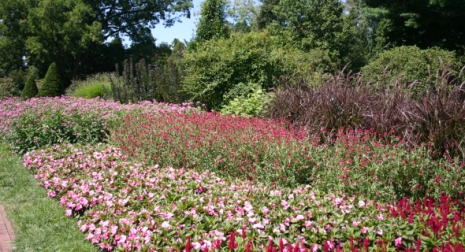Planting annual displays is not (at all) my
favorite gardening pastime, but we do some "color" around our events
building and along the garden entrance to make the area pop during our busy
season.
Those of you who install institutional or commercial color beds are familiar with the process – yank out last season’s annuals/tulips/whatever, smooth out the bed, plant new annuals, then mulch. Or…do you mulch first, then plant?
If the order of events is plant, then mulch, care must be taken not to get it all over the plants. Some over-enthusiastic students practically buried an entire display bed full of stuff last spring (more…is not always better). We spent a great deal of time unearthing the plants, having to pull the mulch away from the crown. Alternatively, if a bed is smoothed and mulched, you have a lovely blank slate to work with, but inevitably end up with the heartbreak of surface dirt chunks and some loss of mulch.
I’m not referring to planting and mulching perennial/mixed borders, veg gardens, or anything like that. Strictly annual displays. But I’d like hear from those experienced with this particular facet of horticulture: before, or after?

Hello, Longwood? Hello Kitty called and wants some of her pink stuff back.
(Seriously, no one does quality color like Longwood Gardens. Except Disney.)
I guess I’m an after mulcher, because I was told early in my gardening career that it’s a bad idea to mulch before the soil gets warm, around the end of May.
If annuals or perennials are not too tall the plastic container is set on top of the plant, then mulch is spread and the container removed. If the plants are too tall so that the container will break flowers or foliage, the plants are dug in, then mulched. It takes a little longer, but the mulch is perfect and no dirt is visible. None of this matters two weeks later when the plants have grown.
I like to mulch (Pacific NW) after I plant bulbs in the fall. Then the perennials and bulbs push their way up and hopefully, fewer weeds appear.
Ahhhh, let’s try this again;-)
Whenever practical, I recommend installing perennials and annuals as plugs with a tree planting bar, I would definitely qualify as an “after” mulcher. Simply drive the bar through the mulch, open a slit, drop in the plug, close the slit with a heal, and move on. As per a previous thread, it’s not too difficult to convince clients that they can ultimately have the same landscape planting for
a third of the cost – if they’re willing to practice the art of patience.
I do mainly container for my clients but for one I mulch after planting the annuals. The other larger display the client already has someone apply the mulch was too early in the spring and way too much so I have to do some careful mulch removal before planting which takes too much time. I can’t seem to educate this client properly.
I do both. I am a one woman operation so to not get too far behind I often do mulching in late winter/early spring. This way I don’t feel so behind when it comes to putting in seasonal color. There are some drawbacks to this method, because some perlite does make it up to the surface makin the beds look slightly less than perfect. But, once the plants fill in it still looks lovely! Also, for me the plant selection and combinations are so stunning, no one but me would even notice the few slight imperfections.
Thanks for the comments! I’d like to be an “after” mulcher, but alas, our gang mulched the naked beds to make them look better for commencement (which occurs prior to our last frost date).
At Kingwood Center in Mansfield, Ohio we have long practiced a very efficient mulching system in our bedding out schemes. After pullng the tulips and preparing the beds we put down a mulch of chopped leaves that have been composting since the fall. It is easy to plant through and makes a very effective mulch. It is much faster than mulching after planting.
Using coco hulls, the answer has to be “after.” The hulls form a crust when first watered, and this helps retain water and combat weeds. Breaking through the crust to plant would be counter-productive. (The crust reverts back to individual hulls later in the season, but that would be too late to plant.)